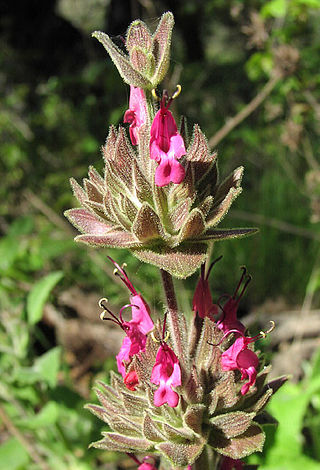
Salvia spathacea, the California hummingbird sage or pitcher sage, is a species of flowering plant in the family Lamiaceae, native to southern and central California growing from sea level to 610 m (2,001 ft). This fruity scented sage blooms in March to May with typically dark rose-lilac colored flowers. It is cultivated in gardens for its attractive flowering spikes and pleasant scent.
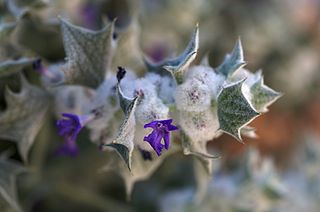
Salvia funerea, is a species of semi-deciduous perennial shrub with the common names Death Valley sage, woolly sage, and funeral sage, is an intricately branched shrub associated with limestone soils in the Mojave Desert in California and Nevada. It is characterized by an overall white appearance due to wooly hairs that cover the stems and leaves.

Salvia pratensis, the meadow clary or meadow sage, is a species of flowering plant in the family Lamiaceae, native to Europe, western Asia and northern Africa. The Latin specific epithet pratensis means "of meadows", referring to its preferred habitat. It also grows in scrub edges and woodland borders.

Chorispora tenella is a species of flowering plant in the mustard family known by several common names, including purple mustard, blue mustard, musk mustard, and crossflower. This mustard is native to parts of Eurasia but is well known in other parts of the world, particularly in temperate regions, as an introduced species and a noxious weed.

Eriastrum pluriflorum is a species of flowering plant in the phlox family known by the common names Tehachapi woollystar and many-flowered eriastrum.

Lycium andersonii is a species of flowering plant in the nightshade family, Solanaceae. Its common names include water-jacket, redberry desert-thorn, Anderson thornbush, Anderson's desert thorn, Anderson boxthorn, Anderson lycium, Anderson wolfberry, and squawberry.

Fallugia is a monotypic genus of flowering plants containing the single species Fallugia paradoxa, which is known by the common names Apache plume and póñil. This plant is native to the southwestern United States and northern Mexico, where it is found in arid habitats such as desert woodlands and scrub.

Lepechinia ganderi is a rare species of perennial shrub in the mint family known by the common name San Diego pitcher sage or Gander's pitcher sage. An aromatic plant with white to lavender flowers, this species is only known from southern San Diego County in California and a small portion of Baja California, occurring on chaparral or coastal sage scrub in metavolcanic soils. Because of its limited range, it is under threat from growing urbanization and increased fire frequency.
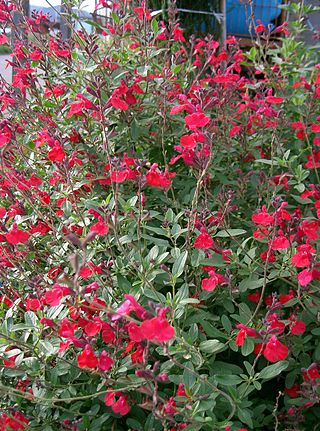
Salvia microphylla, synonyms including Salvia grahamii, Salvia lemmonii and Salvia neurepia, the baby sage, Graham's sage, or blackcurrant sage, is an evergreen shrub found in the wild in southeastern Arizona and the mountains of eastern, western, and southern Mexico. It is a very complex species which easily hybridizes, resulting in numerous hybrids and cultivars brought into horticulture since the 1990s. The specific epithet microphylla, from the Greek, means "small leaved". In Mexico it is called mirto de montes, or "myrtle of the mountains".

Salvia brandegeei is a perennial evergreen shrub in the mint family known by the common names Santa Rosa Island sage or Brandegee's sage. It is a fragrant plant characterized by lavender flowers and dark green leaves. For many years, it was thought to be native only to Santa Rosa Island, one of the Channel Islands of California, until it was discovered along the coast of Baja California. It is threatened by development and mining along the mainland portions of its range, but otherwise has a stable population on Santa Rosa Island.
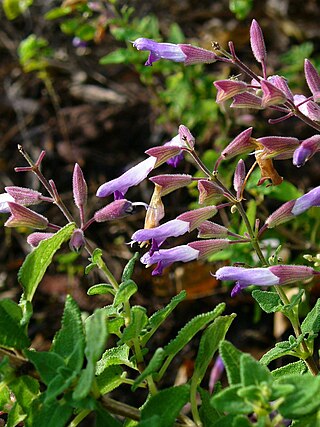
Salvia semiatrata is a species of perennial plant native to the Sierra Madre del Sur in the Mexican state of Oaxaca, growing at elevations of 6,500 ft (2,000 m) or higher. It prefers the edges of pine forests, and is also found on limestone cliffs and banks and in cactus scrub habitats that are dry and exposed.
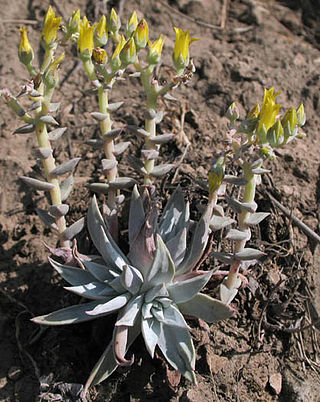
Dudleya verityi is a rare species of succulent plant known by the common name Verity's liveforever. It is endemic to Ventura County, California, where it is known from only three occurrences in the vicinity of Conejo Mountain between Camarillo and Thousand Oaks. It probably occurs in a few additional locations nearby which have not yet been officially vouchered.

Lycium cooperi is a species of flowering plant in the nightshade family known by the common name peach thorn. It is native to the southwestern United States, where it grows in a variety of desert and mountain habitat types. This is a bushy, erect shrub approaching a maximum height of 4 metres (13 ft) with many rigid, thorny branches. The branches are lined thickly with fleshy oval or widely lance-shaped leaves each 1–3 centimetres (0.39–1.18 in) long and coated with glandular hairs. The inflorescence is a small cluster of tubular flowers roughly 1–2 centimetres (0.39–0.79 in) long including the calyx of fleshy sepals at the base. The flower is white or greenish with lavender or green veining. The corolla is a tube opening into a face with four or five lobes. The fruit is a yellow or orange berry under a centimeter wide containing many seeds.

Pholisma arenarium is a species of flowering plant in the borage family known by several common names, including desert Christmas tree, scaly-stemmed sand plant, and purple sand food. As the name implies, the loaf-like part of the root is edible. It is native to northwestern Mexico, Arizona and southern California, where it grows in many habitat types, including desert, chaparral, and sandy coastal dunes. It is a fleshy perennial herb taking a compact cylindrical or ovate shape up to 20 or 30 centimeters tall above ground, often with part of the stem below the sandy surface. It is a parasitic plant growing on the roots or of various shrubs such as burrobush, Yerba Santa, California croton, rabbitbrush, and ragweeds. As a heterotroph which derives its nutrients from other plants, it lacks chlorophyll and is brownish-gray or whitish in color. There are hairy, glandular, pointed leaves along the surface of the plant. Flowers emerge between them, each roughly one centimeter wide, the rounded corolla lavender to deep or bright purple with a white margin.

Salvia munzii is a semi-evergreen perennial species of sage known by the common name Munz's sage or San Miguel Mountain sage. It is native to northern Baja California, Mexico, and it can be found in a few locations just north of the border in San Diego County, California, where it is particularly rare. It is characterized by small leaves and clear blue flowers. It is a member of the coastal sage scrub and chaparral plant communities.
Solanum dimidiatum is a species of plant in the family Solanaceae known by the common names western horsenettle, Torrey's nightshade, and robust horsenettle. It is native to the central United States, where it grows in many types of habitat, including disturbed areas. In California it is known as an introduced species and a noxious weed. It is a rhizomatous perennial herb producing an erect stem up to 80 centimeters tall. It is covered in yellow prickles and branched hairs. The leaves may be up to 15 centimeters long, their edges wavy to lobed and sometimes toothed. The inflorescence is a branching array of several flowers. Each flower has a bell-shaped corolla measuring 3 to 5 centimeters wide. It is lavender to purple, or white. The five large, yellow anthers are about a centimeter long. The fruit is a spherical yellow berry up to 3 centimeters wide.

Liatris ohlingerae is a rare species of flowering plant in the family Asteraceae known by the common names Florida blazing star, Florida gayfeather, scrub blazing star, and sandtorch. It is endemic to Florida in the United States, where it occurs only on the Lake Wales Ridge along with many other rare plants. It is threatened by the loss and degradation of its habitat, and it is federally listed as an endangered species.

Conradina grandiflora is a species of flowering plant in the mint family known by the common name largeflower false rosemary, or large-flowered rosemary. It is endemic to Florida in the United States, where it occurs on the Atlantic Coastal Ridge. Its distribution spans Brevard, Broward, Dade, Highlands, Indian River, Martin, Osceola, Palm Beach, Polk, St. Lucie, and Volusia Counties.
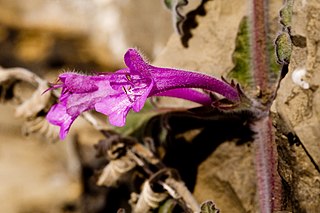
Salvia summa, the great sage or supreme sage, is a herbaceous perennial plant that is native to a small area in southern New Mexico, an adjacent area in northern Texas, and in Chihuahua, Mexico. The plant grows on limestone cliffs in part shade at 1,520 to 2,140 m elevation.

Penstemon eriantherus is a species of flowering plant in the plantain family known by the common names fuzzytongue penstemon and crested beardtongue. It is native to western North America, where it occurs in western Canada and the northwestern and north-central United States.




















